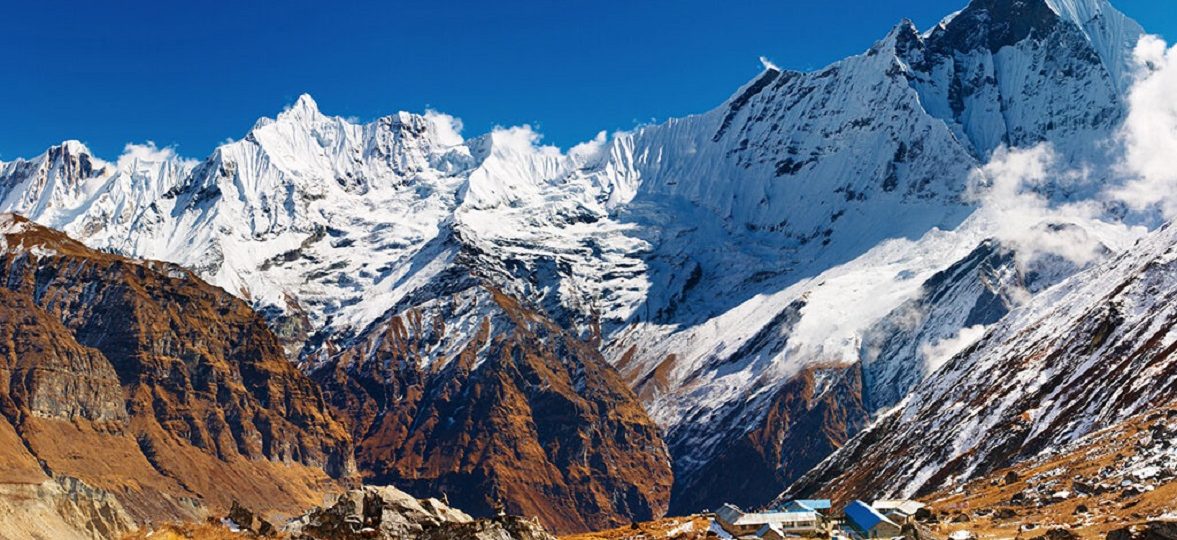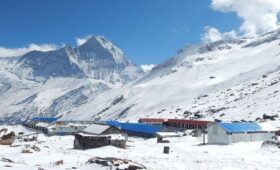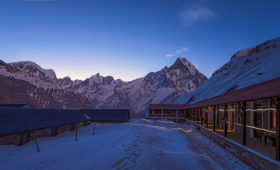With frequent rankings as one of the top ten treks in the world, Annapurna Base Camp trek is a popular trek among all the adventure seekers. You can take this trek throughout the year. Yet, autumn and spring are the best time.
As autumn and spring are the best seasons, it is also the peak trekking season. During these seasons, you get clear views, dry surrounding, and perfect weather. Thus, expect a crowd in the busy trails around Everest and Annapurna region.
Annapurna Base Camp Trek is a perfect combination of natural and cultural sightseeing in the Annapurna region. It displays stunning mountain ranges, unique Gurung culture, managed trails with diverse biodiversity. These amazing features make this trek majestic.
Anyone can join this trek. With the slow pace and enough acclimatization, one can complete the trek in success. However, before taking any trek you need to know the weather conditions and best seasons of the region.
Top 5 Reasons to Choose Annapurna Base Camp Trek
Beautiful Scenery: The trek offers some of the most stunning and diverse landscapes in the world, with snow-capped mountains, lush forests, and picturesque villages.
Local Cultural Experience: The trek takes you through many traditional Gurung villages where you can experience the local culture, food, and lifestyle of the Gurung people.
Medium Difficulty: The trek is considered to be moderately difficult, making it accessible to most people with reasonable fitness levels. The trek does not require any technical hiking skills, and the trails are well-maintained.
Great Adventure: Trekking to Annapurna Base Camp is an adventure of a lifetime and a great way to challenge yourself mentally and physically.
Accommodations: The trek has a well-established trekking infrastructure with plenty of accommodation options available along the trails.
Annapurna Base Camp Trek in Spring (March – May)
With the heat emerging slowly, this is the second-best season to take the Annapurna trek. The warmth makes you comfortable in the higher altitudes.
However, early springs that are around march can be a bit chilly. The average temperature is mid-low at lower altitudes (800-2000m). This makes trekking in lower Annapurna very pleasant.
April is the perfect time for the crystal clear views. The average daytime temperature at lower altitude is around 10-degree Celsius. While the night is usually at freezing.
As you go higher it gets colder. At over 4000m, it is usually freezing cold in the evenings and mornings.
The May weather is usually warmer and there are chances of some rainfall. Average Annapurna Base Camp temperature at this time is 15 – 18 degree at day and 7 – 8 degrees at night.
In Spring the ecosystem of Annapurna region flourishes fully. The rhododendron forest comes in full bloom. You will see them in everywhere, it makes the surrounding absolutely amazing.
Late spring is pre-monsoon season in Annapurna region. So, clouds may appear after mid-day with slight haze and precipitation.
The lower Annapurna region can get uncomfortably hot in this season. Hence it is important to drink plenty of water. And it is also wise to dress in layers during this time.
Pros
- A Beautiful ecosystem with crystal clear views.
- Temperature is moderate with fewer trekkers than in autumn.
Cons
- Afternoon clouds can cause haze and precipitation.
- The temperature increases towards the end which can make you sweaty and uncomfortable.
Annapurna Base Camp Trek in Summer (June – August)
Summers are the monsoon season in Nepal. The temperature is quite high, especially during the day. While in the evenings the temperature is quite moderate.
During this time, along with a bright sunny day, the rain persists too. Usually, the clouds cover the mountainous regions. Hence it is wet, humid, and hazy.
It can rain almost every day with occasional thunderstorms. But after the rain, the countryside glows with lush greenery.
Still, the road in the lower route of Annapurna region is muddy and leech infested.
The average daily temperature of Annapurna Base Camp in this season is 18 – 19 degrees Celsius during the day. While it remains around 10-12 degrees Celsius at night.
During this time you can mark various floras and faunas. Hence the place can be useful for botanists and researchers.
The advantage of trekking in monsoon is that the rain keeps away the pollution and dust. Plus, you will encounter fewer trekkers compared to other seasons.
Just, prepare for the downpours. Do not forget to pack waterproof as well as lightweight gears. Also, make sure that they are quick drying and breathable too.
Pros
- Cleaner environment as the rain keeps the dust and pollutants away.
- After the rain, you will get clear views of the surroundings with their lush greenery.
- Witness all the beautiful flora
- Enjoy the beauty and solitude of the mountains with lesser crowds.
Cons
- Wet and humid conditions
- Muddy and slippery trials with leeches.
Annapurna Base Camp Trek in Autumn (September – November)
Autumn is the best trekking season in Nepal. This season witnesses number of trekkers to the Annapurna region. During this time you get to experience the clean, fresh and vitalized area.
This season comes after the monsoon, hence the surrounding is much clear. The weather is clear with mild to warm days and cold nights. However, in the higher altitudes, the nighttime temperature drops into freezing.
This season offers crystal clear mountains views with low rainfall and more sunny days. Due to the favorable weather conditions, this season is the busiest period and receives the highest number of tourists.
Pros
- Stable weather with clear skies and beautiful scenic views.
- Due to the number of trekkers, it is safe for solo treks too
- You will receive the best service.
Cons
- Crowded paths. Not for those who love solitude.
- Accommodation gets full quickly.
- Pre-booking becomes necessary.
Annapurna Base Camp Trek in Winter (December – February)
Trekking to Annapurna Base Camp in winter season is definitely challenging. Yet it is achievable. This will be the best time for all those adventure seekers who love some thrill into their trekking experience.
The winter season has the coldest weather in the Annapurna region. Normally the daytime temperature can range between 9 – 12 degree Celsius. While evenings can drop to sub-zero degrees.
The mornings are foggy in winter but the afternoons are usually clear where the mountain vistas are at their best. Also, there is occasional snowfall in the mountains.
Though the weather is cold you will find warm meals in the tea houses. Some tea houses also let you into their kitchen area where you can warm yourself.
Along the trail, you may also see the beautiful displays of rhododendrons. They begin to bloom towards the end of the winter.
You need to do is prepare yourselves physically prior to the trek by doing some exercises.
Since there will be few visitors during this time, you will have the region all by yourself. It is great for those who enjoy solitude with nature. Also, the prices are quite low.
Pros
- Clear skies and perfect views for stunning photography.
- The routes are quiet and peaceful and the prices for food and accommodation are comparatively less.
- Celebrate new year or Christmas in the mountains with the locals.
Cons
- Due to heavy snowfall, some of the high passes remain closed
- Requires more planning and equipment due to colder climates
- Chances of Avalanches, heavy snowfalls are prominent.
Conclusion
Trekking to Annapurna Base Camp is possible throughout the year and every season has its own unique feature. But, Autumn and Spring are the best seasons due to the favorable weather and breathtaking views.
However, if you wish to avoid crowds and spend some alone time with nature, winters can be an option.
Trekking during summer will face rainfalls but it could be great for keen botanists.
With all these details, do consider that the weather in the mountainous region of Nepal can be unpredictable. Hence it is important to check on the weather conditions before you plan your trek.
If you have further question and queries, please contact us. It is our pleasure to guide and assist you with the best of our knowledge.





